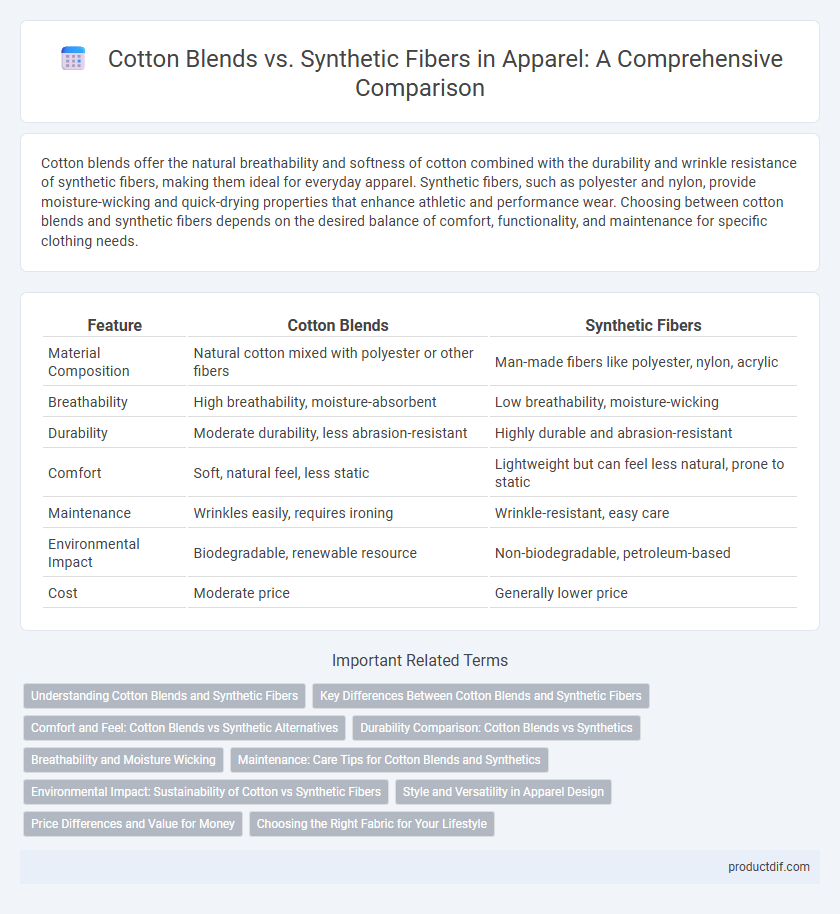Cotton blends offer the natural breathability and softness of cotton combined with the durability and wrinkle resistance of synthetic fibers, making them ideal for everyday apparel. Synthetic fibers, such as polyester and nylon, provide moisture-wicking and quick-drying properties that enhance athletic and performance wear. Choosing between cotton blends and synthetic fibers depends on the desired balance of comfort, functionality, and maintenance for specific clothing needs.
Table of Comparison
| Feature | Cotton Blends | Synthetic Fibers |
|---|---|---|
| Material Composition | Natural cotton mixed with polyester or other fibers | Man-made fibers like polyester, nylon, acrylic |
| Breathability | High breathability, moisture-absorbent | Low breathability, moisture-wicking |
| Durability | Moderate durability, less abrasion-resistant | Highly durable and abrasion-resistant |
| Comfort | Soft, natural feel, less static | Lightweight but can feel less natural, prone to static |
| Maintenance | Wrinkles easily, requires ironing | Wrinkle-resistant, easy care |
| Environmental Impact | Biodegradable, renewable resource | Non-biodegradable, petroleum-based |
| Cost | Moderate price | Generally lower price |
Understanding Cotton Blends and Synthetic Fibers
Cotton blends combine natural cotton fibers with synthetic materials such as polyester or spandex, enhancing durability, stretch, and moisture-wicking properties while maintaining breathability and comfort. Synthetic fibers, including nylon, polyester, and acrylic, offer increased strength, wrinkle resistance, and quick-drying capabilities but may lack the softness and breathability of natural fibers. Understanding the differences helps consumers choose apparel that balances comfort, performance, and maintenance based on specific needs.
Key Differences Between Cotton Blends and Synthetic Fibers
Cotton blends combine natural cotton fibers with synthetic materials like polyester or spandex, offering enhanced breathability, softness, and moisture absorption compared to purely synthetic fibers, which excel in durability, wrinkle resistance, and elasticity. Synthetic fibers such as nylon, acrylic, and polyester typically provide better stretch and quicker drying times but may trap heat and reduce overall comfort. The choice between cotton blends and synthetic fibers depends on desired fabric performance factors including comfort, maintenance, durability, and intended garment use.
Comfort and Feel: Cotton Blends vs Synthetic Alternatives
Cotton blends offer superior breathability and softness, making them ideal for comfortable everyday wear compared to synthetic fibers like polyester or nylon, which often trap heat and moisture. These natural-cotton mixtures provide a gentle feel against the skin, reducing irritation and enhancing comfort over long periods. Synthetic alternatives, while durable and moisture-wicking, can sometimes feel less breathable and cause discomfort in warm or humid conditions.
Durability Comparison: Cotton Blends vs Synthetics
Cotton blends offer moderate durability by combining natural fiber breathability with added strength from synthetic components like polyester or nylon. Synthetic fibers, such as polyester and nylon, typically outperform cotton blends in abrasion resistance, tensile strength, and color retention, making them more suitable for high-wear apparel. However, cotton blends provide better moisture absorption and comfort, balancing durability with wearability in everyday clothing.
Breathability and Moisture Wicking
Cotton blends offer superior breathability, allowing air to circulate and keeping the skin cool during wear. Synthetic fibers, such as polyester and nylon, excel in moisture-wicking by quickly drawing sweat away from the body to the fabric surface for evaporation. Combining cotton blends with synthetic fibers in apparel maximizes comfort by balancing natural breathability with efficient moisture management.
Maintenance: Care Tips for Cotton Blends and Synthetics
Cotton blends require washing in cold water and tumble drying on low to prevent shrinking and maintain softness, while synthetic fibers benefit from gentle machine washing with mild detergents and air drying to avoid heat damage and static buildup. Avoid bleach on both fabrics to preserve color and fiber integrity, and ironing is best done on low heat for cotton blends and cautiously for synthetics to prevent melting or warping. Proper maintenance extends the lifespan of apparel by reducing wear and tear while keeping fabric texture and color vibrant.
Environmental Impact: Sustainability of Cotton vs Synthetic Fibers
Cotton blends offer renewable, biodegradable fibers that reduce microplastic pollution compared to synthetic fibers like polyester, which are petroleum-based and contribute to long-term environmental degradation. The water consumption and pesticide use in conventional cotton farming pose sustainability challenges, yet organic cotton blends provide a more eco-friendly alternative. Synthetic fibers' energy-intensive production and non-biodegradability lead to higher carbon footprints and persistent environmental waste, making sustainable cotton blends preferable for eco-conscious apparel.
Style and Versatility in Apparel Design
Cotton blends offer a unique combination of natural softness and improved durability, making them ideal for versatile apparel designs that maintain comfort and breathability. Synthetic fibers, such as polyester and nylon, provide enhanced elasticity and wrinkle resistance, enabling styles that require shape retention and vibrant colors. Designers often leverage cotton blends for casual, breathable garments, while synthetic fibers dominate in performance wear and fashion pieces needing stretch and longevity.
Price Differences and Value for Money
Cotton blends typically cost more upfront than synthetic fibers but offer enhanced breathability, comfort, and durability, delivering superior value for everyday wear. Synthetic fibers, such as polyester and nylon, are generally less expensive and provide excellent moisture-wicking and wrinkle resistance, making them ideal for budget-conscious consumers prioritizing easy care. Evaluating price differences alongside performance features helps shoppers select apparel that balances cost with long-term wearability and maintenance.
Choosing the Right Fabric for Your Lifestyle
Cotton blends offer breathability and natural comfort, making them ideal for everyday wear and sensitive skin. Synthetic fibers like polyester provide durability, moisture-wicking, and quick-drying properties, suited for active lifestyles and outdoor activities. Selecting the right fabric depends on balancing comfort, maintenance, and performance based on daily activities and personal preferences.
Cotton Blends vs Synthetic Fibers Infographic

 productdif.com
productdif.com